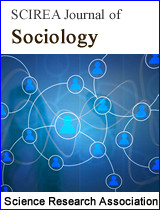The link between inbreeding and family security in Jordan
DOI: 10.54647/sociology84781 79 Downloads 13910 Views
Author(s)
Abstract
The family is society's basic cell and cornerstone, its goodness mirrored by its goodness, its corruption mirrored by its corruption, its strength mirrored by its strength, and its weakness mirrored by its weakness. Every healthy civilization has a healthy family, and every ill society has a sick family.
Genetic diseases such as "mental retardation, diabetes, hemophilia, anemim, heart disease and color blindness" can be passed down through the generations from parents to their offspring.
Islamic law has taken care of young people who are preparing to marry, has advised them against marrying relatives, and has given them intelligent guidance on how to build a family on healthy and stable grounds.
Consanguineous marriage aims to preserve the family name and strengthens and consolidates family relations. It also aims to ensure the inheritance so that the family money is not transferred through the wife to someone outside the family environment. Some of the customs, traditions and customs prevalent in some societies are strongly associated with consanguinity.
As a result, young people who are ready to marry must be notified of the disadvantages of cohabitating marriage and its detrimental influence on family security.
Keywords
Family Security; marriage; kinship; social customs; genetic diseases; family income; educational level
Cite this paper
Fatma zein,
The link between inbreeding and family security in Jordan
, SCIREA Journal of Sociology.
Volume 6, Issue 3, June 2022 | PP. 158-178.
10.54647/sociology84781
References
| [ 1 ] | Al-Ahmar, A. S. (2004). Sociology of the Family: Between Theorizing and Changing Reality. United New Book House, Beirut: Lebanon. |
| [ 2 ] | Al-Anani, H. A. (2019). The Child, the Family and Society. Dar Al-Safa Publishing and Distribution, Amman. |
| [ 3 ] | Al-Ashi, M- M- R., (2018). The Impact of Genetic Diseases on Marital Life. College of Sharia and Law, Gaza: Palestine. |
| [ 4 ] | Al-Eithan, A. (2005). Marriage of Consanguineous and Expatriate. Dar Al-Kifah for Publishing and Distribution, First edition: Saudi Arabia. |
| [ 5 ] | Al-Haddad, A. B. (2018). The Marriage of Consanguinity between Jurisprudence and Medicine. Dar Al-Hamad for Publishing and Distribution, Dubai: United Arab Emirates. |
| [ 6 ] | Al-Hajji, M. A. (2016). Genetics. Arab House for Publishing and Distribution, Second Edition: Cairo. |
| [ 7 ] | Al-Masry, M. (2016). The Happy Islamic Marriage. Al-Safa Library, Dar Al-Bayan Modern. |
| [ 8 ] | Al-Sharida, B. (2009). Consanguineous Marriage and the Spread of Diseases. Al-Sharq al-Awsat Newspaper, Thursday, 25 Dhul-Qa’dah 1430 AH, November 12, 2009, (11307. |
| [ 9 ] | Al-Termanini, A. (2016). Marriage among Arabs in Pre-Islamic Times and Islam. Comparative Study, The World of Knowledge. a monthly cultural book series issued by the National Council for Culture, Arts and Letters: Kuwait. |
| [ 10 ] | Amudha, S., Aruna, S., Rajajem, S.. (2015). Consanguinity and chromosomal abnormality. Indian Journal of Human Genetics, 11(2). |
| [ 11 ] | Awad M., Amira, F. (2019). Consanguineous Marriage between Sharia and Medicine - A Comparative Jurisprudential Study. Faculty of Islamic Studies Girls Zagazig, Al-Azhar University. Bakhit, M. A. (2006). The phenomenon of consanguineous marriage and its impact on intellectual disability. Jerash National University: Jordan. |
| [ 12 ] | Camille, S. (2016). Consanguineous Marriage. Dar Al-Yazuri, first edition, Riyadh: Saudi Arabia. |
| [ 13 ] | Ghaith, M. A. (2017). Dictionary of Sociology. University Knowledge House: Alexandria. |
| [ 14 ] | Hamamy H.A., Masri A.T, Al-Hadidy A.M & Ajlouni K.M. (2007). Consanguinity and genetic disorders. Profile from Jordan. Saudi Medical Journal, 28 (7). |
| [ 15 ] | Kharboush, I. F. (2007). Consanguineous marriage. Al-Nahda Library: Cairo. |
| [ 16 ] | Odaibat, S. M. (2011). Premarital Medical Examination An Applied Legal Study. House of Culture for Publishing and Distribution: Amman. |

